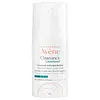Avène Cleanance Smoothing Night Cream Versus Avène Cleanance Comedomed Concentrate Blemish Control Serum
What's inside
What's inside
 Key Ingredients
Key Ingredients

 Benefits
Benefits

 Concerns
Concerns

 Ingredients Side-by-side
Ingredients Side-by-side

Water
Skin ConditioningCaprylic/Capric Triglyceride
MaskingIsododecane
EmollientDimethicone
EmollientGlycerin
HumectantPentylene Glycol
Skin ConditioningPropylene Glycol
HumectantSqualane
EmollientGlyceryl Stearate
EmollientPEG-100 Stearate
Hexylresorcinol
Antimicrobial1,2-Hexanediol
Skin ConditioningAlgin
MaskingArachidyl Alcohol
EmollientArachidyl Glucoside
EmulsifyingBehenyl Alcohol
EmollientBenzoic Acid
MaskingBHT
AntioxidantCaprylyl Glycol
EmollientCarbomer
Emulsion StabilisingDimethicone Crosspolymer
Emulsion StabilisingDimethiconol
EmollientParfum
MaskingHydrogenated Polyisobutene
EmollientHydroxyethyl Acrylate/Sodium Acryloyldimethyl Taurate Copolymer
Emulsion StabilisingPapain
Skin ConditioningPEG-7 Trimethylolpropane Coconut Ether
EmulsifyingCI 17200
Cosmetic ColorantRetinal
Skin ConditioningSodium Hydroxide
BufferingSorbitan Isostearate
EmulsifyingStearyl Alcohol
EmollientCI 77891
Cosmetic ColorantXanthan Gum
EmulsifyingWater, Caprylic/Capric Triglyceride, Isododecane, Dimethicone, Glycerin, Pentylene Glycol, Propylene Glycol, Squalane, Glyceryl Stearate, PEG-100 Stearate, Hexylresorcinol, 1,2-Hexanediol, Algin, Arachidyl Alcohol, Arachidyl Glucoside, Behenyl Alcohol, Benzoic Acid, BHT, Caprylyl Glycol, Carbomer, Dimethicone Crosspolymer, Dimethiconol, Parfum, Hydrogenated Polyisobutene, Hydroxyethyl Acrylate/Sodium Acryloyldimethyl Taurate Copolymer, Papain, PEG-7 Trimethylolpropane Coconut Ether, CI 17200, Retinal, Sodium Hydroxide, Sorbitan Isostearate, Stearyl Alcohol, CI 77891, Xanthan Gum
 Reviews
Reviews

Alternatives
Ingredients Explained
These ingredients are found in both products.
Ingredients higher up in an ingredient list are typically present in a larger amount.
Glycerin is already naturally found in your skin. It helps moisturize and protect your skin.
A study from 2016 found glycerin to be more effective as a humectant than AHAs and hyaluronic acid.
As a humectant, it helps the skin stay hydrated by pulling moisture to your skin. The low molecular weight of glycerin allows it to pull moisture into the deeper layers of your skin.
Hydrated skin improves your skin barrier; Your skin barrier helps protect against irritants and bacteria.
Glycerin has also been found to have antimicrobial and antiviral properties. Due to these properties, glycerin is often used in wound and burn treatments.
In cosmetics, glycerin is usually derived from plants such as soybean or palm. However, it can also be sourced from animals, such as tallow or animal fat.
This ingredient is organic, colorless, odorless, and non-toxic.
Glycerin is the name for this ingredient in American English. British English uses Glycerol/Glycerine.
Learn more about GlycerinSorbitan Isostearate is an emulsifer and cleaning agent. It is created from isostearic acid and sorbitol.
As an emulsifier, Sorbitan Isostearate prevents oils and water from separating.
Due to its isostearic acid base, it may not be safe for Malassezia or fungal acne.
Learn more about Sorbitan IsostearateWater. It's the most common cosmetic ingredient of all. You'll usually see it at the top of ingredient lists, meaning that it makes up the largest part of the product.
So why is it so popular? Water most often acts as a solvent - this means that it helps dissolve other ingredients into the formulation.
You'll also recognize water as that liquid we all need to stay alive. If you see this, drink a glass of water. Stay hydrated!
Learn more about Water